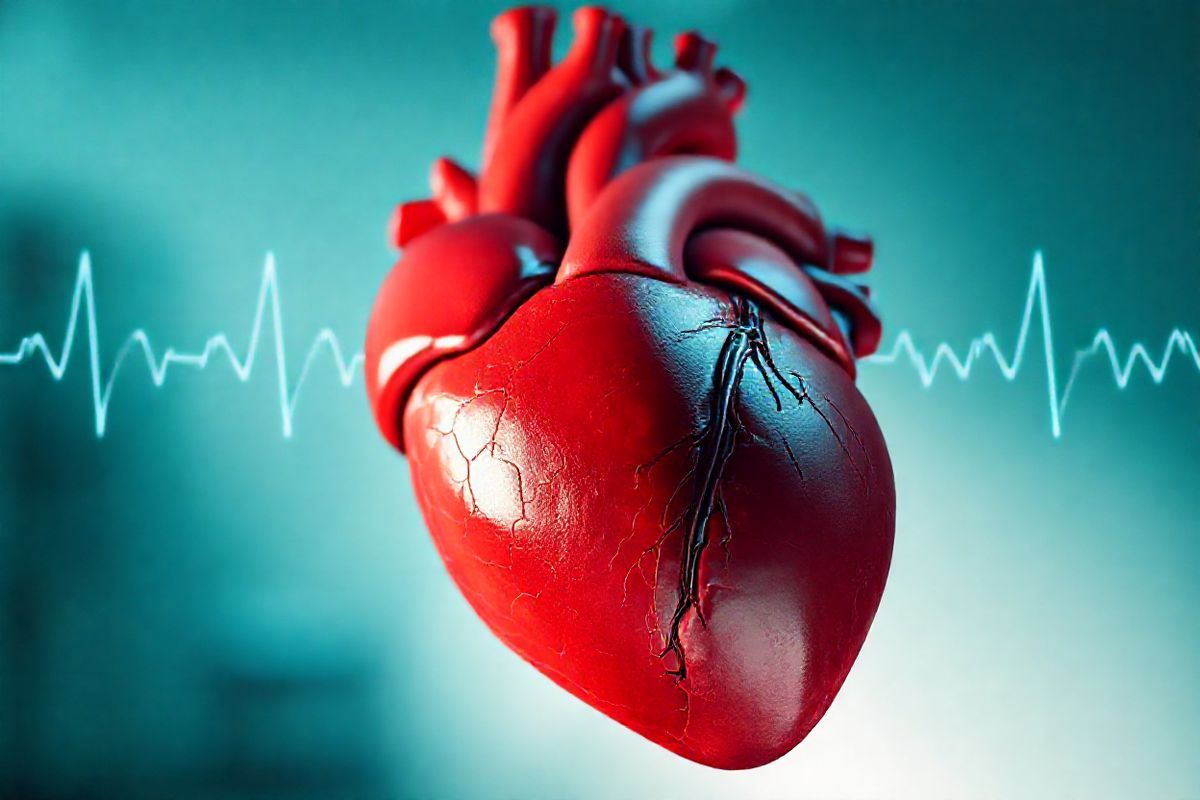Table of Contents
What is Ventricular Tachycardia? A Deep Dive into Heart arrhythmias

Ventricular tachycardia (VT) is a type of arrhythmia characterized by a rapid heartbeat originating from the ventricles of the heart. This condition occurs when the heart’s electrical signals misfire, leading to a fast and potentially dangerous heart rate, typically exceeding 100 beats per minute. VT can be classified as monomorphic or polymorphic, with monomorphic ventricular tachycardia (MVT) being a specific type where the electrical impulses are consistent in shape and form.
The heart’s electrical system is crucial for maintaining a normal rhythm; it consists of specialized cells that generate electrical signals, causing the heart to pump blood effectively. When these signals are disrupted, it can result in arrhythmias such as VT, which can compromise the heart’s ability to pump blood efficiently. Monomorphic VT is often associated with structural heart disease, such as previous myocardial infarction or cardiomyopathy, and can lead to serious complications, including syncope, heart failure, or sudden cardiac death if not managed properly (NHLBI, 2023).
Recognizing the Symptoms of Ventricular Tachycardia
Identifying the symptoms of ventricular tachycardia is essential for timely intervention. Patients may experience a variety of symptoms, which can range from mild to severe. Common symptoms include:
- Palpitations: A sensation of rapid or irregular heartbeat, often described as fluttering in the chest.
- Dizziness or lightheadedness: This may occur due to reduced blood flow to the brain, which can happen when the heart is not pumping effectively.
- Shortness of breath: Patients may struggle to breathe, especially during physical activity or even at rest.
- Chest pain or discomfort: This can be a sign of inadequate blood flow to the heart muscle.
- Fainting (syncope): A temporary loss of consciousness can occur due to decreased blood flow to the brain.
It is important to note that some individuals with monomorphic VT may be asymptomatic, while others may experience significant distress. The presence of symptoms can depend on the duration of the tachycardia, the rate of the heartbeat, and the underlying cardiac condition (Marshfield Clinic, 2023).
Exploring the Causes Behind Ventricular Tachycardia and Heart Arrhythmias

Monomorphic ventricular tachycardia can arise from various underlying conditions. The primary causes can be classified into structural heart diseases, electrolyte imbalances, and other factors:
-
Structural Heart Disease:
- Conditions such as ischemic heart disease, cardiomyopathy, and valvular heart diseases can lead to changes in the heart tissue that predispose individuals to VT.
- Scar tissue from previous heart attacks can disrupt normal electrical conduction pathways, resulting in the development of reentrant circuits that are the hallmark of monomorphic VT.
-
Electrolyte Imbalances:
- Abnormal levels of potassium, magnesium, or calcium can affect the heart’s electrical activity, leading to arrhythmias, including VT.
-
Inherited Conditions:
- Genetic syndromes such as Long QT syndrome or Brugada syndrome can predispose individuals to arrhythmias, including VT.
-
Other Factors:
- Certain medications, excessive alcohol consumption, and stimulants such as caffeine or illicit drugs can trigger episodes of VT in susceptible individuals (NHS, 2024).
Understanding these causes is crucial for the prevention and management of ventricular tachycardia.
The Diagnosis Journey: How is Ventricular Tachycardia Identified?
The diagnosis of ventricular tachycardia typically involves a combination of patient history, physical examination, and diagnostic tests. The following steps are commonly taken:
-
Patient History and Symptoms:
- A detailed account of the patient’s symptoms, including their frequency and duration, is crucial. Family history of heart disease or arrhythmias may also provide valuable insights.
-
Electrocardiogram (ECG):
- An ECG is the primary diagnostic tool used to identify VT. It records the electrical activity of the heart and can show characteristic patterns associated with monomorphic VT, such as a wide QRS complex.
-
Holter Monitor:
- This portable device records the heart’s rhythm over 24 to 48 hours, helping to capture episodes of VT that may not occur during a standard ECG.
-
Electrophysiology Study (EPS):
- In certain cases, an invasive EPS may be performed to map the electrical conduction system of the heart and identify the origin of the VT.
-
Imaging Studies:
- Echocardiography or cardiac MRI can be used to assess cardiac structure and function, helping to identify underlying heart conditions (Hopkins Medicine, 2023).
By thoroughly assessing these factors, healthcare providers can establish a diagnosis and tailor management strategies for patients with ventricular tachycardia.
Managing Ventricular Tachycardia: Treatment Options and Patient Outlook
The management of monomorphic ventricular tachycardia focuses on restoring normal rhythm and preventing future episodes. Treatment options may include:
-
Medications:
- Antiarrhythmic drugs, such as amiodarone or sotalol, may be prescribed to control the heart rate and rhythm. In some cases, beta-blockers may also be utilized to reduce heart rate and improve symptoms.
-
Cardioversion:
- This procedure involves delivering an electrical shock to the heart to restore a normal rhythm. It can be performed urgently in cases of unstable VT.
-
Catheter Ablation:
- For recurrent monomorphic VT, catheter ablation may be considered. This minimally invasive procedure destroys the abnormal electrical pathways responsible for the arrhythmia.
-
Implantable Cardioverter Defibrillator (ICD):
- For patients at high risk of sudden cardiac death, an ICD may be implanted. This device continuously monitors the heart and delivers shocks if it detects dangerous arrhythmias.
-
Lifestyle Modifications:
- Patients may be advised to make lifestyle changes, such as reducing caffeine and alcohol intake, managing stress, and following a heart-healthy diet.
Prognosis
The prognosis for individuals with monomorphic ventricular tachycardia largely depends on the underlying cause and the presence of structural heart disease. Those with well-managed conditions and no significant heart failure may have a favorable outcome. Conversely, individuals with underlying heart disease or those who experience frequent episodes of VT may face a more complicated prognosis, emphasizing the importance of ongoing management and follow-up (Emery-Dreifuss Muscular Dystrophy Study, 2023).
Frequently Asked Questions (FAQ)
1. What triggers monomorphic ventricular tachycardia?
- Monomorphic ventricular tachycardia can be triggered by structural heart disease, electrolyte imbalances, certain medications, or genetic conditions.
2. Can monomorphic ventricular tachycardia be fatal?
- Yes, if not treated, monomorphic VT can lead to serious complications, including sudden cardiac arrest.
3. How is monomorphic ventricular tachycardia diagnosed?
- It is diagnosed through patient history, ECG, Holter monitoring, and in some cases, electrophysiology studies.
4. What treatments are available for monomorphic ventricular tachycardia?
- Treatments may include medications, cardioversion, catheter ablation, and the implantation of an ICD.
5. Is lifestyle modification important in managing monomorphic ventricular tachycardia?
- Yes, lifestyle changes can help reduce triggers and improve overall heart health.
References
-
National Heart, Lung, and Blood Institute. (2023)
-
Marshfield Clinic. (2023). Heart Arrhythmia: Causes, symptoms, treatment. Retrieved from https://www.marshfieldclinic.org/specialties/heart-care/arrhythmia
-
Hopkins Medicine. (2023). arrhythmias. Retrieved from https://www.hopkinsmedicine.org/health/conditions-and-diseases/arrhythmias
-
Emery-Dreifuss Muscular Dystrophy Study. (2023). Much More Than a Stroke: Emery-Dreifuss Muscular Dystrophy Type 2 Revealed by Ischemic Stroke. Retrieved from https://doi.org/10.7759/cureus.73815
-
National Health Service. (2024). Heart rhythm problems (arrhythmia). Retrieved from https://www.nhs.uk/conditions/arrhythmia/











